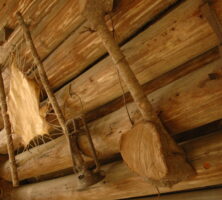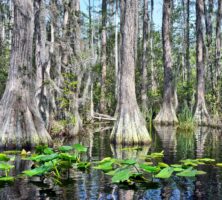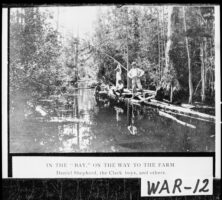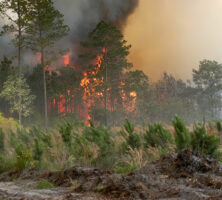The Okefenokee Swamp covers nearly 700 square miles, almost all of which is in Georgia. It has a long history as a wilderness, a public common, and a refuge. Since 1937 most of the Okefenokee has been a National Wildlife Refuge. It was designated a National Wilderness Area in 1974.
Indigenous Communities
Indigenous peoples occupied the Okefenokee during the late Archaic, Woodland, and Mississippian periods of Georgia prehistory. The major occupations were during the Weeden Island and Savannah periods, around A.D. 500 and 1200. Sand mounds were constructed in the swamp during this period.
Spanish records between 1602 and 1768 refer to Okefenokee as Laguna de Oconi (Lake Oconi). At least two Timucuan villages and Spanish missions were located in or near the swamp between 1620 and 1656. William Bartram’s Creek legend, which tells the story of princesses of the sun on an island in the center of the swamp, is probably rooted in stories of the Timucuan settlements.
The Okefenokee was a Creek hunting ground in the late eighteenth and early nineteenth centuries. Briefly in 1836 and for most of 1838 the Second Seminole War in Florida extended into the Okefenokee. Roads and forts were built around the perimeter of the swamp, and Georgia militia and U.S. army troops patrolled intensively. They burned down a Seminole village on an island that they subsequently renamed Floyds Island, for Charles Rinaldo Floyd. In response to this violence, the Seminole began to leave the swamp in 1838, but skirmishes continued to occur along the Georgia-Florida boundary as late as 1840.
White Settlement
A few white families settled on the southeastern edge of the Okefenokee as early as 1805. Settlers moved into the areas east, north, and west of the swamp after the land lottery of 1820. These pioneers herded cattle, raised hogs, hunted and fished, and cultivated small corn patches and gardens. They lived in log cabins. They occasionally visited Traders Hill or Centre Village, trading hides, jerky, and pelts for salt, ammunition, trinkets, and entertainment. A few families moved onto islands in the swamp during the 1850s. The self-sufficient lifestyle of these settlers largely continued until the early twentieth century.
As the area industrialized in the late nineteenth and early twentieth centuries, the lives of residents, known as swampers, gradually changed. Given their knowledge of the landscape and local ecology, swamp dwellers served as early guides for various surveyors. Some found work in expanding industries, and others sold their land to large lumber companies. As historian Megan Kate Nelson noted, “for some Swamper families, hard cash was irresistible. Their abandonment of their Okefenokee homes was often rooted in a need for money in addition to a conviction that they could either move to another part of the swamp or continue to exercise their hunting and heading rights within the Okefenokee.”
Industrial Development
Sailing vessels visited Traders Hill, fewer than ten miles outside the Okefenokee, by the first decade of the nineteenth century, and steamboats regularly traveled the St. Marys River by the 1830s. Outside of these developments, there was little change in the Okefenokee landscape or livelihood until the railroads reached the rim of the great swamp in the 1860s.
The Atlantic and Gulf Railroad from Savannah was built a few miles north of the Okefenokee by the start of the Civil War (1861-65). Another railroad, from Brunswick to Albany, passed north of the swamp in 1870. With the railroads came sawmills and turpentine stills, store-bought goods, circuses, and new people. A line connected Waycross and Jacksonville, Florida, in 1881, passing within less than a mile of the eastern edge of the swamp. A railroad from Valdosta to Jacksonville was completed in 1898, closing the ring of railroad tracks around the swamp. Industrialization brought jobs at sawmills, turpentine stills, and on the railroads. Steam transformed both the Okefenokee culture and the landscape after 1880. By 1900 the old-growth longleaf pine forest that encircled the swamp was a forest of stumps.
The Georgia legislature in 1889 authorized Governor John B. Gordon to sell the Okefenokee property. The Suwanee Canal Company purchased the property on January 1, 1891. The company attempted to drain the swamp from 1891 until 1893. They built a sawmill and purchased steamboats and steam logging equipment in an effort to raise money by harvesting the cypress timber. Both ventures collapsed in 1897. In 1899 the property was sold to the family of Captain Henry Jackson of Atlanta, the canal company’s former president. Charles Hebard and his sons purchased the Jackson property in 1901.
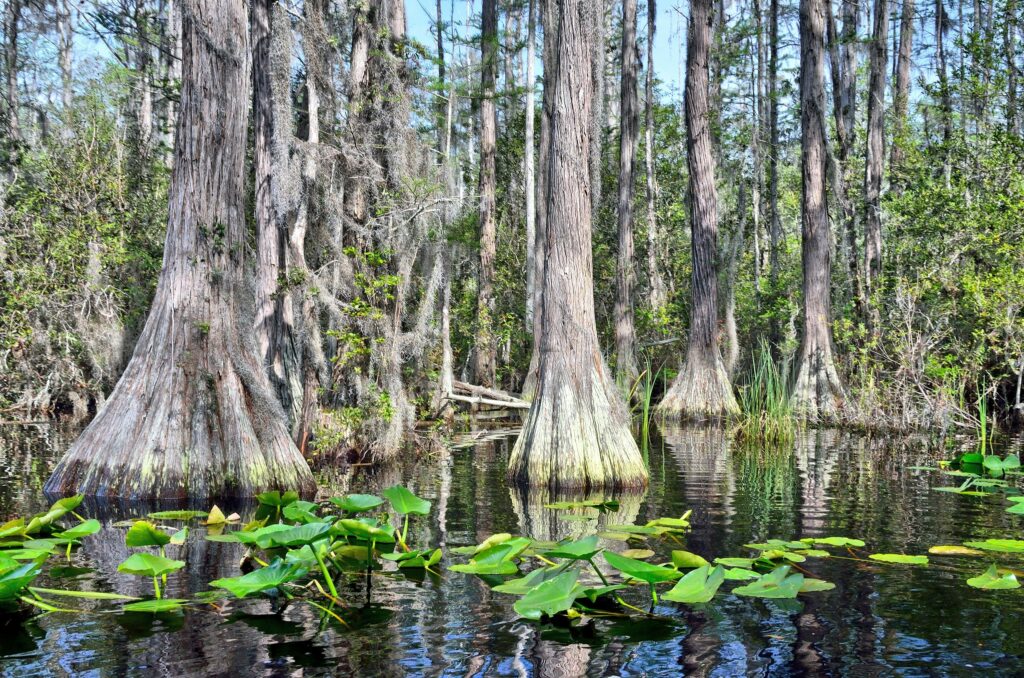
Image from Timothy J
Learning from the mistakes of the Suwanee Canal Company, the Hebard Lumber Company carefully studied the timber of the swamp and decided to employ railroads to harvest cypress. They leased the property to the Hebard Cypress Company, which built a large sawmill near Waycross and constructed a railroad to the northwestern rim of the swamp in 1909-10. Over the next fifteen years the company systematically built railroads across the swamp and logged the cypress trees of the northern and western Okefenokee.
Other companies, especially the Americus Manufacturing Company, conducted railroad logging operations in the swamp between 1910 and 1926. The big companies ceased operations in 1926-27. Individuals and small companies logged the remaining stands of cypress and pine during the late 1920s; Johnson and Sons Lumber Company may have logged as late as 1942.
Preservation Efforts
Daniel Hebard, the son of the Hebard Lumber Company’s founder, built a hunting cabin in the hammock on Floyds Island in 1925. Family and friends camped on the island during the following decade, usually hunting ducks. A caretaker named Billy Spaulding lived in a hut on the island.
During this period writers and naturalists were also permitted to camp in the cabin on Floyds Island Hammock. Many articles extolling the wonders of the Okefenokee wilderness were published in newspapers, magazines, and books. A number of writers urged that the swamp be purchased as a refuge.
The Okefenokee Society was organized in 1918 in Waycross. Members of the society petitioned the federal government to purchase the Hebard property as a biological preserve, but the society died with its founder, J. F. Wilson, in 1921. The Georgia Society of Naturalists took up the crusade in 1929. Their efforts, supported by other organizations and individuals.
Georgia Coastal Flatwoods Upland Game Project
While conservation organizations promoted the purchase of the Hebard property as a refuge, other development plans were afoot. Some organizations promoted schemes to build a ship canal across the swamp; others pushed for the construction of a scenic highway. The federal government purchased about 40,000 acres of cut-over and burned-over lands on the northeast side of the swamp in 1935. Workers with the Georgia Coastal Flatwoods Upland Game Project planted trees and grass and developed parks. The work was primarily intended to produce jobs through the federal Works Progress Administration program, part of U.S. president Franklin D. Roosevelt’s New Deal initiative. The federal government turned the project over to the state of Georgia in 1938 and sold the land to the state much later, probably in 1955. Dixon Memorial Forest Wildlife Management Area and two state parks, Laura S. Walker State Park and Okefenokee Swamp Park, were developed on this tract.
Okefenokee Wildlife Refuge
In 1937 the federal government purchased the Hebard Lumber Company property, and Roosevelt created the Okefenokee Wildlife Refuge (now the Okefenokee National Wildlife Refuge) by executive order. An all-Black unit of the Civilian Conservation Corps was transferred to the refuge, and between 1937 and 1941 they developed facilities there, which are still in use today. Designating the Okefenokee a wildlife refuge preserved the swamp but drove out its residents. Swamp dwellers were told they could no longer kill bears and wildcats in order to protect their livestock. The residents found it impossible to support themselves, and over time they moved away. All residents were likely gone by 1958. The size of the refuge has increased over the years. In 1937 the government purchased 292,979 additional acres. Today the refuge comprises 396,000 acres.

Courtesy of Explore Georgia.
For the first several decades the staff at the Okefenokee National Wildlife Refuge devoted much of its time to maintaining roads and facilities and protecting wildlife from poachers. Since the 1950s the U.S. Fish and Wildlife Service has focused on managing the habitat for wildlife through fire management and by protecting and fostering endangered and threatened wildlife species. Recreation and environmental education have also become more important functions at the refuge. Development of the Suwannee Canal Recreation Area, on the eastern edge of the swamp, began in the mid-1960s.

Courtesy of U.S. Fish and Wildlife Service
Fluctuations of water levels, even minute changes, have a significant effect on the Okefenokee ecosystem. After the drought and wildfires of 1954-55, the federal government constructed an earthen dam, the Suwannee River Sill, on the western side of the swamp to maintain water levels during drought. It was not effective. Plans to breach the sill are being implemented.
Recent Developments
Camp Stephen Foster was established in 1948 as a private concession within the refuge. The state of Georgia acquired the concession as Stephen C. Foster State Park in 1954. In 1974, 353,981 acres of the refuge were included in the National Wilderness System. A Wilderness Canoe Trail system was instituted in the 1970s. The Ramsar Convention on Wetlands, an international convention that promotes the preservation of waterfowl habitat, recognized the Okefenokee as a wetland of international importance in 1986.
On April 16, 2007, a downed power line southwest of Waycross started the Sweat Farm Road fire. On May 5, two lightning strikes on Bugaboo Island in the Okefenokee Swamp sparked a fire that merged with the Sweat Farm Road blaze to become the largest wildfire in Georgia’s history, and among the largest in Florida’s history. The fire, which has been called the Bugaboo Scrub Fire and the Georgia Bay Complex Fire, burned more than 564,000 acres in Georgia and Florida, shut down interstate highways 10 and 75, and, in the end, cost more than $80,000,000 in lost timber and reforesting costs. The fire was maintained by drought conditions and forty smaller fires across the region, which were mostly started by careless burning and arson. The fire was finally contained in late June 2007. There were no casualties, but nine homes were lost.

Photograph from FEMA
On April 28, 2011, another lightning strike in the Okefenokee Swamp ignited a massive wildfire called the Honey Prairie Fire. The fire burned more than 300,000 acres in the swamp over the course of three months.










